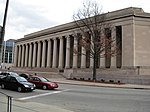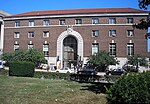Roman Catholic Diocese of Pittsburgh
1843 establishments in PennsylvaniaChristianity in PittsburghReligious organizations established in 1843Roman Catholic Diocese of PittsburghRoman Catholic dioceses and prelatures established in the 19th century ... and 3 more
Roman Catholic dioceses in the United StatesSource attributionUse mdy dates from August 2016

The Diocese of Pittsburgh (Latin: Diœcesis Pittsburgensis) is a Latin Church ecclesiastical jurisdiction or diocese of the Catholic Church in Western Pennsylvania established on August 11, 1843. The diocese includes 188 parishes and 225 churches in the counties of Allegheny, Beaver, Butler, Greene, Lawrence, and Washington, an area of 3,786 sq mi (9,810 km2) with a Catholic population of 630,033 as of 2019. The cathedral church of the diocese is the Cathedral of Saint Paul. As of July 2021, the diocese had 194 active priests.
Excerpt from the Wikipedia article Roman Catholic Diocese of Pittsburgh (License: CC BY-SA 3.0, Authors, Images).Roman Catholic Diocese of Pittsburgh
North Dithridge Street, Pittsburgh
Geographical coordinates (GPS) Address Phone number Website Nearby Places Show on map
Geographical coordinates (GPS)
| Latitude | Longitude |
|---|---|
| N 40.447222222222 ° | E -79.949722222222 ° |
Address
St. Paul Cathedral
North Dithridge Street 108
15213 Pittsburgh
Pennsylvania, United States
Open on Google Maps






